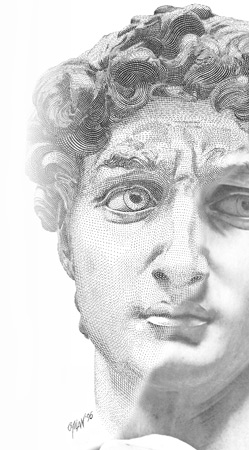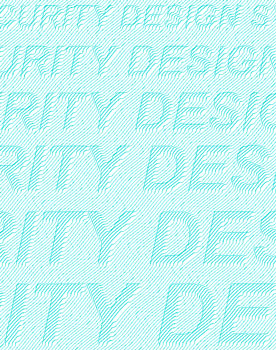- Giotto
- Technical approach
- Features
- Precision
- DEMO
- System Configuration & Download
- Company & Contact
Security Design System |
| Giotto, the famous Italian painter was said to be able to draw perfect circles by hand. Our system has been conceived to design and draw perfect security graphic elements that may contain desired imperfections which combined produce the best effects against counterfeiting. After all, nobody is perfect. |
The main idea is to constantly provide new security elements and dynamic variations so as to stay one step ahead of counterfeiters and their available techniques, without creating extreme complex procedures for the securities designer or artist. |
 |
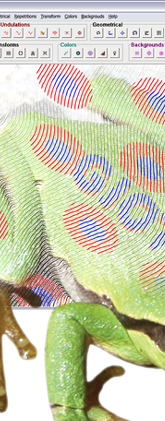 |
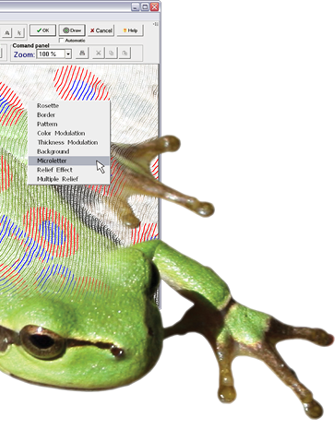 |
|
| However, we have conceived the system as part of an artistic process, which requires the artist or designer to investigate the proper shapes or designs suitable for the final harmonic composition, an additional reason to create unique designs. | 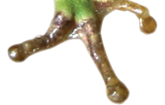 |
Giotto work's window screenshot | ||
Technical approach |
|||
Authentic rosettes are made up of a complex mathematical representation that resembles the operation of a traditional mechanical or electro-mechanical guilloche machine which starts drawing at a certain point and returns exactly to the departure point, always maintaining a continuous path with the line. Such traditional concept is enhanced by the design options offered by the software in that the line can be thickened or slimmed in certain areas as desired or following a grayscale picture background, including the possibility to create a three dimensional effect with the rosette. The purpose of such variations on the line thickness is to reflect the original engravings where this variation was obtained by pressing harder on the engraving tool. |
|||
|
Features |
|||
Giotto allows the artist to create guilloche security backgrounds that are generated following a static repetitive design which can be enriched by the possibility to make one or more parameters to dynamically change in an automatic way, creating a design where each line is different from the next, (Step Variable option). These elements can be distorted by modifying the design plane or by adding a dynamically varying parameter which creates progressive changes adding complexity to the final result without compromising the artistic harmony or aesthetics of the final product. |
|||
 |
|||
Rosettes are made up of groups of guilloches including negative elements that match each other mathematically allowing the composition of several elements in different colors with perfect register. This guilloche group concept is also valid for the generation of linear borders or complete frames typically used for shares, certificates, passports or even checks. Furthermore, the density or concentration of line paths can be increased or decreased creating lighter or darker areas, as well as using negative elements or “rings”. |
|||
|
|||
| Latent image elements creation, either negative or positive, effective both in offset and specially designed for Intaglio printing, as well as the generation of the Void or Photocopy pattern. These latent images can be simple line art patterns or guilloches with a two level line pattern, or they can be further enriched by adding a background gray scale image to produce dynamic line width modulation. Designed Shapes allows the operator to create any form outside the program, import such design and use it as borders for a guilloche to flow inside, or the shape of a generating function. The Gray scale relief effect option offers the possibility to obtain a gradual relief effect proportional to the intensity of gray, (256 levels) coming from the background image or text. Such option offers an even more interesting effect with the addition of the line width modulation. |
|
|||||||||||
System Configuration |
||||||||||||
The minimum system configuration is made up of a personal computer station with a high quality scanner, a color proof printer, commercial pagination software packages and the Giotto software package. The complete turn key system for high quality film output includes a 4000, 8000 or even 12000 DPI photounit depending on special requirements, and can be easily integrated to an existing installation or work in standalone mode in a high security production room. Giotto runs under MS Windows 95/98 or NT/2000® only on PC platforms, and can generate graphic files in several formats so as to render the elements compatible with most of the existing composition programs in the market today. Some of these formats are EPS (Encapsulated PostScript), TIFF (Tagged Image File Format), PS (PostScript) or Bitmap, which are known as the most common grafic formats. Finally, all designs are generated with a resolution that can go up to the micron, (25’400 dpi) however such precision is not necessary since the existing photounits go as high as 12’000 dpi, (only for some special applications). Any resolution can be defined, but the standard resolutions for most photounits in the market are: 3000, 3600, 4000, 5080 or even 8000 dpi and can be selected from the options menu within the program. |
||||||||||||
|
||||||||||||
|
||||||||||||
|
||||||||||||
|
||||||||||||
|
Company profile |
|||||||||||||
|
|||||||||||||
Pitagora S.A. was founded in Lugano Switzerland in 1997, to concentrate the dedication as well as the efforts of several engineers towards the development and use of new technologies in two very distinctive fields, such as Data Acquisition and Security Printing. |
|||||||||||||
Please contact us, as follows:
|
|||||||||||||
 |
View Larger Map | ||||||||||||
